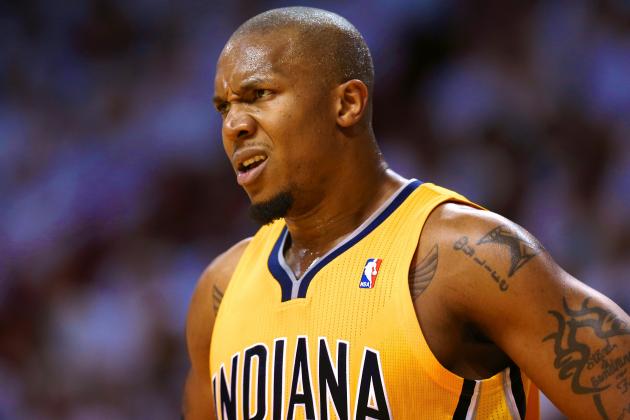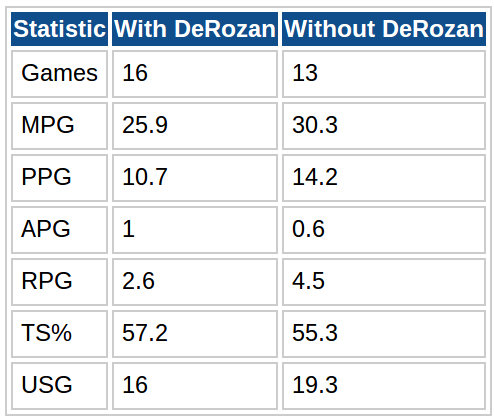Welcome to the Weekend 3-on-2, a weekly (maybe) feature that looks at three things the Raptors do well, and two things they don’t.
That’s love: Terrence Ross’s increased confidence
Like most fans, I’ve flip-flopped on Ross a million times. He’s chalked full of potential — he’s quick, he can jump out of the gym and his shooting stroke is butter — but he’s wildly inconsistent. On some nights, Ross blends into the background and is hardly noticeable. On others, his 3-point shooting and breath-taking athleticism takes center stage.
After DeMar DeRozan injured his groin, a slight opportunity opened up for Ross in the starting unit. He hasn’t exactly taken the reigns and run with the spot, as he did following the Rudy Gay trade, but Ross has stepped up, however marginally, without DeRozan. His splits, pre and post DeRozan injury (before the Clippers game) are as shown below.
The most obvious jump is the two-fold increase in rebounds per game. The obvious explanation there is that Ross is no longer being asked to leak out as often in transition, thus he is crashing the glass more often. It’s a nice bump, but somewhat meaningless, as it more so points to the role of rebounders in Toronto’s system, than anything else.
Rebounding aside, the biggest jump in Ross’s numbers is his increased scoring output, which is attributable to Ross’s increased confidence when it comes to shooting. That change is reflected in the jump in Ross’s usage rate, as well. Ross is noticeably more aggressive in terms of getting his and is launching more 3-pointers outside of what can be considered his normal comfort range. Normally, Ross gets his 2-3 triples per game on spot-ups around pin-downs, in transition and on drive-and-kicks, but Ross has been willing to out step those narrow boundaries of late.
It’s all about a mindset. It’s not a particularly good shot to take, but it’s nice to see plays like the one below. Ross didn’t back down to the challenge of attacking one-on-one and cans a jumper on Arron Afflalo (so jealous).
I don’t like: Ross is still not driving (enough)
Unfortunately, despite more opportunities to handle the ball, Ross has continued to shy away from driving into the paint, a trend that I wrote about during the offseason. This season, Ross is driving the ball an average of 1.4 times per game (per NBA Stats), which puts him in the company of players like Pistons swingman Kyle Singler (1.3) and Suns small forward P.J. Tucker (1.2), ranking him 254th in the NBA. In the words of president Jeb Bartlett, “not nearly enough.”
To an extent, the absence of drives is an unfair critique of Ross. It’s not necessarily his role to drive and with each passing season, it’s becoming more and more likely that Ross’s skillset simply does not include attacking the basket. If we accept these limitations as truths for Ross, then calling for him to drive is as unfair as bemoaning Jonas Valanciunas’s lack of a 3-point shot. Maybe Ross just doesn’t have the ability to drive.
If these are truths for Ross, which is not certain, as Ross is still only 23, the Raptors’ offense finds itself in a bit of a jam. The Raptors have an abundance of perimeter weapons between Kyle Lowry, Lou Williams, DeMar DeRozan and Ross himself, but as DeRozan’s absence has shown, there’s a bridge between the interior and the 3-point line that needs to be gapped by drivers. When the initial pick-and-roll action fails, it’s imperative that the ball can be quickly reset for a similar attack from the opposite side of the court. When the Raptors’ offense (which is more than fine, by the way) is flowing, defenders are forced to constantly rotate, which creates open shot opportunities.
With DeRozan out, the onus falls on players like Ross to replicate the same downhill action. Ross has fared nicely with a surprisingly effective pull-up midrange jumper (shooting above 45% from 10 feet out to the 3-point line), but the drives still aren’t there. Check out the changes in Ross’s shot location before and after DeRozan’s injury. He’s actually taking less shots in the paint, albeit slightly, while launching more jumpshots.
 With less drives to the basket also comes less opportunities for free throws, which carries ramifications for the Raptors’ defense. Hitting free throws allows the defense to be set and necessarily limits transition opportunities. With DeRozan’s in the lineup, the Raptors attempted an average of 29.2 free throws per game. Without DeRozan, the Raptors are averaging just 22.5 free throws per game.
With less drives to the basket also comes less opportunities for free throws, which carries ramifications for the Raptors’ defense. Hitting free throws allows the defense to be set and necessarily limits transition opportunities. With DeRozan’s in the lineup, the Raptors attempted an average of 29.2 free throws per game. Without DeRozan, the Raptors are averaging just 22.5 free throws per game.
Again, this isn’t necessarily a critique of Ross. If driving simply isn’t in his repertoire, Ross and the Raptors are stuck relying on the jumper until DeRozan returns. That strategy has worked thus far — the Raptors are scoring at a historic rate — but the down side of inflexibility is apparent.
That’s love: Ross’s push shot
The “what,” is that Ross isn’t attacking the basket very much. The “how,” however, has changed. The Raptors’ offense has added a few wrinkles since last season, featuring a few cuts for Ross which makes use of his athleticism and quickness. The play below is a nice example (via theScore), where the Raptors run a pair of curls towards the basket.
Ross has also flashed signs of a developing push shot, which is a nice counter to throw at opponents who overplay the jumper. Ross doesn’t like absorbing contact on his drives, so this is a nice finesse option.
Hey, it’s hope. Maybe Ross has a few tricks up his sleeves. Dammit. I’m even flip-flopping on Ross within a singular article. How ironic.
I don’t like: Acquiring David West
The appeal is there. I can see that. West is a proven veteran who has played a role in a number of playoff runs. With the Pacers struggling to cobbled together much of anything this season without Paul George, there’s reason to believe that West could be had in a potential trade. It’s hard to see the Pacers turning down an offer of Chuck Hayes, Landry Fields and a 1st-rounder for West’s services.
But is West really the same player that played an integral role in Indiana and New Orleans’s playoff pushes? His numbers are down across the board, sure, but it’s the underlying signs that are most worrisome. Only 9 percent of West’s attempts are coming from within 3 feet of the basket, down for 20 percent a season prior. The “17-foot Assassin” has always been more pick-and-pop than pick-and-roll, but he’s practically never getting to the rim anymore. His 12.8 points are almost strictly coming off mid-range jumpers this season. Even his post opportunities ends up with West launching jumpers.
To his credit, West is an knockdown shooter from the midrange and he knows where to place himself to get open looks. However, West can’t really stretch the floor as he isn’t much of a 3-point shooter, nor does he ever get to the free-throw line. His 1.2 free-throw attempts per game is on par with Ross’s average of 1 per game, and I just spent an entire section outlining the problem with Ross’s lack of ability to attack the paint. Those same problems are magnified for non-floor-stretching frontcourt players.
All of this says nothing of West’s contract, which calls for him to earn $12 million this season and another $12 million next year on a player option. Should he pick up the last double-digit annual salary of his career in 2015-16, the Raptors would be severely handcuffed with respect to cap space which would likely spell the end of Amir Johnson’s tenure in Toronto, unless Ujiri feels inclined to keep three marginal power forwards around for nearly 30 million going forward (he won’t).
It’s nice that West is a gritty defender with an abundance of veteran intangibles on his resume. But what’s tangible, that being his play this season and his potential fit on the Raptors, isn’t worth the price of the Raptors’ immediate assets.
Rather, a low-cost option like swapping Hansbrough and a 2nd-round pick for a mobile big like Ed Davis would be a smarter move. Davis brings shot blocking, rebounding and a potential pick-and-roll partner for Vasquez and he’s on a dirt-cheap contract.
That’s love: Splashing cash in free agency
Are you itching for the Raptors to make an upgrade? Me too. But Masai Ujiri is likely best served to grab an upgrade in the offseason when he has cap space and assets on hand to make moves.
Let’s take stock. Assuming the cap jumps to $66.5 million, and that Raptors renounce the rights to their impending free agents (Hayes, Hansbrough, Williams, Amir, Fields, Stiemsma), the Raptors will have roughly $18 million to spend on a potential free agent. Depending on a player’s years of service, that figure is roughly equivalent to that of a max contract.
The goal should be to grab an absolute upgrade at a position (preferably in the frontcourt). Don’t cough up assets for short term fixes like West or Kevin Garnett. Think big. Think Al Jefferson (player option), Paul Millsap, Tyson Chandler, DeAndre Jordan, Marc Gasol, Andrea Bargnani (lol), LaMarcus Aldridge, Wes Matthews or Goran Dragic.
Happy holidays, everyone. Don’t be one of those crazy shoppers that ends up on the evening news.




